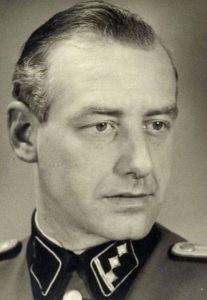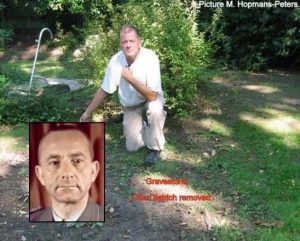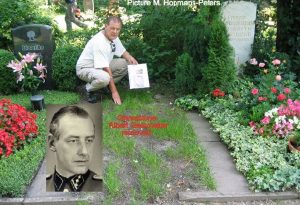Gemmeker, Albert Konrad, born 23-09-1907 in Düsseldorf  At the age of fourteen, Gemmeker left school and went to work for an insurance company for a few years. When Gemmeker was twenty years old, he reported to the police and trained as a police officer. After completing his education in 1933, he joined the police force in Duisburg. In 1935 Gemmeker had an administrative position with the Gestapo. He was not a member of the NSDAP or SS at the time, but was considered reliable.
At the age of fourteen, Gemmeker left school and went to work for an insurance company for a few years. When Gemmeker was twenty years old, he reported to the police and trained as a police officer. After completing his education in 1933, he joined the police force in Duisburg. In 1935 Gemmeker had an administrative position with the Gestapo. He was not a member of the NSDAP or SS at the time, but was considered reliable.
 At the age of fourteen, Gemmeker left school and went to work for an insurance company for a few years. When Gemmeker was twenty years old, he reported to the police and trained as a police officer. After completing his education in 1933, he joined the police force in Duisburg. In 1935 Gemmeker had an administrative position with the Gestapo. He was not a member of the NSDAP or SS at the time, but was considered reliable.
At the age of fourteen, Gemmeker left school and went to work for an insurance company for a few years. When Gemmeker was twenty years old, he reported to the police and trained as a police officer. After completing his education in 1933, he joined the police force in Duisburg. In 1935 Gemmeker had an administrative position with the Gestapo. He was not a member of the NSDAP or SS at the time, but was considered reliable.He followed a Police training in Duisburg, became a member of the NSDAP  01-05-1937, in 1938 he entered the Gestapo
01-05-1937, in 1938 he entered the Gestapo  and joined the SS
and joined the SS  on 01-11-1940. On 25-08-1940 he came to the Netherlands as a civil servant in Den Hague and promoted to Oberstürmführer
on 01-11-1940. On 25-08-1940 he came to the Netherlands as a civil servant in Den Hague and promoted to Oberstürmführer  in 1942. He always considered the Jews people as Untermenschen, inferior people, and parasites and was a real Nazi and a career hunter. He saw the deportations of Jews as war necessity, “Kriegsnotwendig”. He became the commander of the hostage camp in St Michielsgestel and promoted to SS Oberstürmführer with the command of the Police Jews Transit Camp, in Westerbork.
in 1942. He always considered the Jews people as Untermenschen, inferior people, and parasites and was a real Nazi and a career hunter. He saw the deportations of Jews as war necessity, “Kriegsnotwendig”. He became the commander of the hostage camp in St Michielsgestel and promoted to SS Oberstürmführer with the command of the Police Jews Transit Camp, in Westerbork.
 01-05-1937, in 1938 he entered the Gestapo
01-05-1937, in 1938 he entered the Gestapo  and joined the SS
and joined the SS  on 01-11-1940. On 25-08-1940 he came to the Netherlands as a civil servant in Den Hague and promoted to Oberstürmführer
on 01-11-1940. On 25-08-1940 he came to the Netherlands as a civil servant in Den Hague and promoted to Oberstürmführer  in 1942. He always considered the Jews people as Untermenschen, inferior people, and parasites and was a real Nazi and a career hunter. He saw the deportations of Jews as war necessity, “Kriegsnotwendig”. He became the commander of the hostage camp in St Michielsgestel and promoted to SS Oberstürmführer with the command of the Police Jews Transit Camp, in Westerbork.
in 1942. He always considered the Jews people as Untermenschen, inferior people, and parasites and was a real Nazi and a career hunter. He saw the deportations of Jews as war necessity, “Kriegsnotwendig”. He became the commander of the hostage camp in St Michielsgestel and promoted to SS Oberstürmführer with the command of the Police Jews Transit Camp, in Westerbork.
 In Juli 1942 this camp was used as transit camp for Jews on their way to the destruction camps in Poland. He led the camp very strict and organized. From October 1942 until April 1945 he was responsibly for the transport of about 80.000 Jewish people, as well the family of Anne Frank (see Simon Wiesenthal)
In Juli 1942 this camp was used as transit camp for Jews on their way to the destruction camps in Poland. He led the camp very strict and organized. From October 1942 until April 1945 he was responsibly for the transport of about 80.000 Jewish people, as well the family of Anne Frank (see Simon Wiesenthal)  .
. He allowed the prisoners sport, music and cabaret performances, all with a smile, but one day he shot at a prisoner who came too close to the gate. The last deportation from Westerbork was on 13-09-1944 and the girl in the door opening is the 9 years old Sinti girl Anne Maria “Settela” Steinbach
He allowed the prisoners sport, music and cabaret performances, all with a smile, but one day he shot at a prisoner who came too close to the gate. The last deportation from Westerbork was on 13-09-1944 and the girl in the door opening is the 9 years old Sinti girl Anne Maria “Settela” Steinbach  from my hometown of Eindhoven, a famous picture, she died in the gas chamber of Auschwitz. SS Hauptsturmführer, Josef Mengele
from my hometown of Eindhoven, a famous picture, she died in the gas chamber of Auschwitz. SS Hauptsturmführer, Josef Mengele

 infamous for performing human experiments on camp inmates in Auschwitz, including children, for which Mengele was called the “Angel of Death”.
infamous for performing human experiments on camp inmates in Auschwitz, including children, for which Mengele was called the “Angel of Death”.

Gemmeker “escaped” the camp at last on 11-04-1945 to Amsterdam and the camp became liberated by the Canadians, but Gemmeker had already left to Amsterdam, where he worked” innocent” as an administration leader fort Jewish immigration. With the liberation of the Netherlands (see About) (see Jack Brook) 

 Jack put first Allied steps on Dutch soil in WWII and donated me with his original beret badge
Jack put first Allied steps on Dutch soil in WWII and donated me with his original beret badge  . Gemmeker was captured with his colleagues and in a prison in Assen for interrogations. He was transferred to his own camp of Westerbork, now a internment camp for NSB members, collaborators and Germans. The trial in Assen condemned him to 12 years in prison, but later in January 1949, he became 10 years, because of his “good” behaviour as commander and too little evidence for mass murder. He always denied to have known of the mass murders in the concentration camps. Anne Frank
. Gemmeker was captured with his colleagues and in a prison in Assen for interrogations. He was transferred to his own camp of Westerbork, now a internment camp for NSB members, collaborators and Germans. The trial in Assen condemned him to 12 years in prison, but later in January 1949, he became 10 years, because of his “good” behaviour as commander and too little evidence for mass murder. He always denied to have known of the mass murders in the concentration camps. Anne Frank


 Jack put first Allied steps on Dutch soil in WWII and donated me with his original beret badge
Jack put first Allied steps on Dutch soil in WWII and donated me with his original beret badge  . Gemmeker was captured with his colleagues and in a prison in Assen for interrogations. He was transferred to his own camp of Westerbork, now a internment camp for NSB members, collaborators and Germans. The trial in Assen condemned him to 12 years in prison, but later in January 1949, he became 10 years, because of his “good” behaviour as commander and too little evidence for mass murder. He always denied to have known of the mass murders in the concentration camps. Anne Frank
. Gemmeker was captured with his colleagues and in a prison in Assen for interrogations. He was transferred to his own camp of Westerbork, now a internment camp for NSB members, collaborators and Germans. The trial in Assen condemned him to 12 years in prison, but later in January 1949, he became 10 years, because of his “good” behaviour as commander and too little evidence for mass murder. He always denied to have known of the mass murders in the concentration camps. Anne Frank
 and her family, father, mother and sister Margo, were integrated in Westerbork too, before leaving to Bergen Belsen, where they starved, father Otto Frank survived, he died old age 91, on 19-08-1980,
and her family, father, mother and sister Margo, were integrated in Westerbork too, before leaving to Bergen Belsen, where they starved, father Otto Frank survived, he died old age 91, on 19-08-1980,

 remarried in Bazel, Switzerland.
remarried in Bazel, Switzerland.Death and burial ground of Gemmeker, Albert Konrad.



Gemmeker was in prison only for six years and went to Düsseldorf and lived with his conscience with his wife Elisabeth Helena Hassel-Mullender .

 Gemmeker had three daughters, whom he didn’t see much after he divorced his wife. According to his granddaughter Anke, he left the Westerbork prisoners “intelligent and calculating” in the delusion that nothing bad was about to happen. She remembered him as a distant man. The contact with her grandfather did not last long. Her mother, who had given a daughter the name Ruth, broke off contact with him after he reacted negatively to being given that Jewish name. His claim that he had learned to appreciate Jews through camp life and that he had learned there that anti-Semitism is based on prejudice is a lie, according to Anke Winter.
Gemmeker had three daughters, whom he didn’t see much after he divorced his wife. According to his granddaughter Anke, he left the Westerbork prisoners “intelligent and calculating” in the delusion that nothing bad was about to happen. She remembered him as a distant man. The contact with her grandfather did not last long. Her mother, who had given a daughter the name Ruth, broke off contact with him after he reacted negatively to being given that Jewish name. His claim that he had learned to appreciate Jews through camp life and that he had learned there that anti-Semitism is based on prejudice is a lie, according to Anke Winter.


 Gemmeker had three daughters, whom he didn’t see much after he divorced his wife. According to his granddaughter Anke, he left the Westerbork prisoners “intelligent and calculating” in the delusion that nothing bad was about to happen. She remembered him as a distant man. The contact with her grandfather did not last long. Her mother, who had given a daughter the name Ruth, broke off contact with him after he reacted negatively to being given that Jewish name. His claim that he had learned to appreciate Jews through camp life and that he had learned there that anti-Semitism is based on prejudice is a lie, according to Anke Winter.
Gemmeker had three daughters, whom he didn’t see much after he divorced his wife. According to his granddaughter Anke, he left the Westerbork prisoners “intelligent and calculating” in the delusion that nothing bad was about to happen. She remembered him as a distant man. The contact with her grandfather did not last long. Her mother, who had given a daughter the name Ruth, broke off contact with him after he reacted negatively to being given that Jewish name. His claim that he had learned to appreciate Jews through camp life and that he had learned there that anti-Semitism is based on prejudice is a lie, according to Anke Winter.Yet it has been known for some time that Gemmeker had two faces. For example, he once shot a shotgun at prisoner Frits Spier, who he thought was walking too close to the barbed wire. “Yes, I did indeed”, he told Mauritz Frankenhuis  in 1948. Frankenhuis was in Camp Westerbork during the war. After the war he had an interview with Gemmeker and his mistress and secretary, Frau Hassel’, ‘Ly Hassel’ she said: Frau Hassel in the prison in Assen. Frau Hassel was shocked by the incident. Not so much because her lover shot at a prisoner out of the blue. No, next time Gemmeker had to warn her so she could cover her ears.
in 1948. Frankenhuis was in Camp Westerbork during the war. After the war he had an interview with Gemmeker and his mistress and secretary, Frau Hassel’, ‘Ly Hassel’ she said: Frau Hassel in the prison in Assen. Frau Hassel was shocked by the incident. Not so much because her lover shot at a prisoner out of the blue. No, next time Gemmeker had to warn her so she could cover her ears.
 in 1948. Frankenhuis was in Camp Westerbork during the war. After the war he had an interview with Gemmeker and his mistress and secretary, Frau Hassel’, ‘Ly Hassel’ she said: Frau Hassel in the prison in Assen. Frau Hassel was shocked by the incident. Not so much because her lover shot at a prisoner out of the blue. No, next time Gemmeker had to warn her so she could cover her ears.
in 1948. Frankenhuis was in Camp Westerbork during the war. After the war he had an interview with Gemmeker and his mistress and secretary, Frau Hassel’, ‘Ly Hassel’ she said: Frau Hassel in the prison in Assen. Frau Hassel was shocked by the incident. Not so much because her lover shot at a prisoner out of the blue. No, next time Gemmeker had to warn her so she could cover her ears.Arrested May 1945 Rotterdam and in a witness statement (04-12-1945) stood up for Gemmeker and called him ‘The Jesus Christ of Westerbork’ She was released in 1947:1948: Arrested again and interrogated several times. 07-01-1949 released again, no prosecution.”Whereas she is guilty of the war crime of willfully assisting in the unlawful deprivation of liberty of a large number of persons; in view of the time spent in custody, determines that the person concerned is unconditionally released from prosecution in that regard.Pre-trial detention: 3 years: no penalty. She thought that pretrial detention was justified as a punishment for her part in the deportations. 1950: married Ernst Stoll.
Gemmeker died on 30-08-1982, at the age of 74 and is buried on the Nordfriedhof of Düsseldorf. Close by are the graves of different “famous” WW II personalities, Generalmajor der Infanterie, Kommandeur der 271th Volkgrenadier Division , Martin Bieber, Hitler’s Press Chief, Otto Dietrich,
, Martin Bieber, Hitler’s Press Chief, Otto Dietrich, 
 Generalmajor der Flieger, Kommandeur 7th Flak Division, Alfred Erhard, Hitler’s favourite architects, Hermann Giesler and Arno Breker,
Generalmajor der Flieger, Kommandeur 7th Flak Division, Alfred Erhard, Hitler’s favourite architects, Hermann Giesler and Arno Breker, 
 Generalleutnant der Artillerie,Kommandeur der 526th Infanterie Division, Fritz Kühne the diplomat in Paris, Ernst vom Rath
Generalleutnant der Artillerie,Kommandeur der 526th Infanterie Division, Fritz Kühne the diplomat in Paris, Ernst vom Rath
 , Martin Bieber, Hitler’s Press Chief, Otto Dietrich,
, Martin Bieber, Hitler’s Press Chief, Otto Dietrich, 
 Generalmajor der Flieger, Kommandeur 7th Flak Division, Alfred Erhard, Hitler’s favourite architects, Hermann Giesler and Arno Breker,
Generalmajor der Flieger, Kommandeur 7th Flak Division, Alfred Erhard, Hitler’s favourite architects, Hermann Giesler and Arno Breker, 
 Generalleutnant der Artillerie,Kommandeur der 526th Infanterie Division, Fritz Kühne the diplomat in Paris, Ernst vom Rath
Generalleutnant der Artillerie,Kommandeur der 526th Infanterie Division, Fritz Kühne the diplomat in Paris, Ernst vom Rath
 , killed in Paris by the Jewish boy Herschel Grynspan,
, killed in Paris by the Jewish boy Herschel Grynspan,
 the occasion for Goebbels and Himmler
the occasion for Goebbels and Himmler 
 to organize the Crystal Night in Germany, on 09-11-1938
to organize the Crystal Night in Germany, on 09-11-1938  . Grynszpan’s fate is unknown. However, he most probably did not survive the war. One report said he was executed in 1940 while Fritz Dahms, an official in the German Foreign Office, revealed that he had died just before the end of the World War II. Also buried there are General der Panzertruppe, Kommandeur 1st Panzer Division
. Grynszpan’s fate is unknown. However, he most probably did not survive the war. One report said he was executed in 1940 while Fritz Dahms, an official in the German Foreign Office, revealed that he had died just before the end of the World War II. Also buried there are General der Panzertruppe, Kommandeur 1st Panzer Division SS Oberrgruppenführer, Höhere SS und Polizei Führer Nord, Fritz Weitzel and Generalleutnant der Fallschirmtruppe, Kommandeur 3rd Fallschirmjäger Division
SS Oberrgruppenführer, Höhere SS und Polizei Führer Nord, Fritz Weitzel and Generalleutnant der Fallschirmtruppe, Kommandeur 3rd Fallschirmjäger Division , Richard Schimpf.
, Richard Schimpf.  The 3rd division went into combat in June 1944 in Normandy. In August it was virtually destroyed in the area of Falaise. Formed again in Belgium thanks to replacements from 22nd, 51st, 53rd Luftwaffe Field Regiments
The 3rd division went into combat in June 1944 in Normandy. In August it was virtually destroyed in the area of Falaise. Formed again in Belgium thanks to replacements from 22nd, 51st, 53rd Luftwaffe Field Regiments  . During September 1944 it fought as a part of Kampfgruppe “Becker” in Arnhem area. It surrendered in April 1945 to American troops in Ruhr. Alas Gemmeker’s gravestone is removed since a few years, but his mortal remains still there.
. During September 1944 it fought as a part of Kampfgruppe “Becker” in Arnhem area. It surrendered in April 1945 to American troops in Ruhr. Alas Gemmeker’s gravestone is removed since a few years, but his mortal remains still there.
Message(s), tips or interesting graves for the webmaster: robhopmans@outlook.com



















Leave a Reply